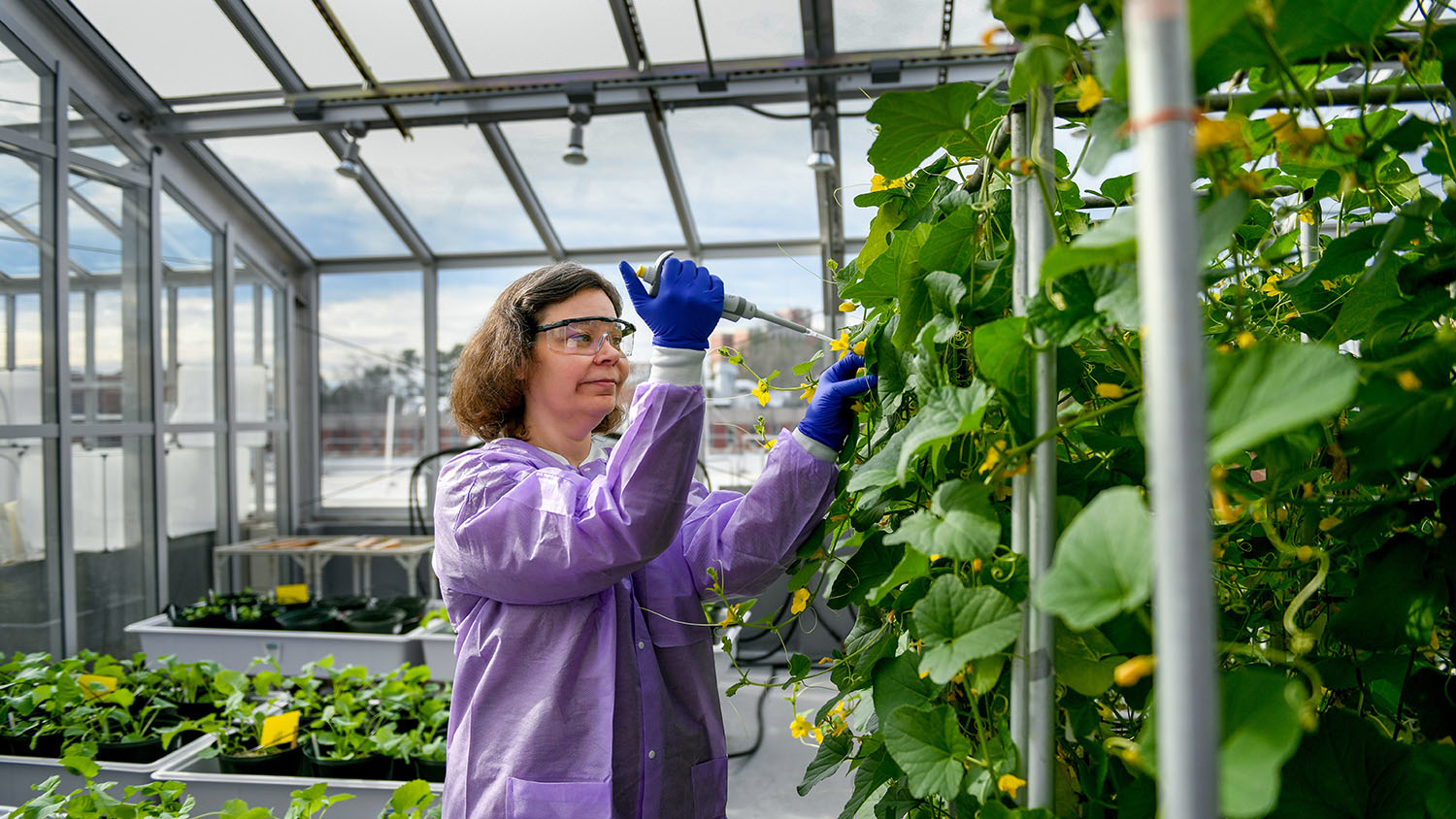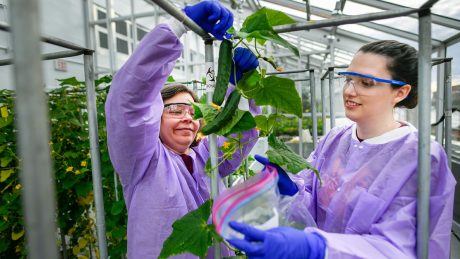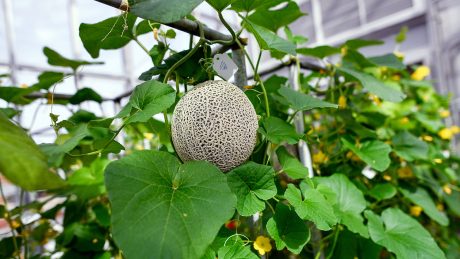Securely Studying Salmonella to Advance Produce Safety

Among the extensive facilities at NC State’s Phytotron is a secure greenhouse that is specially designed to allow scientists to study bacteria, fungi and viruses that infect plants — or contaminate produce causing foodborne illness — in a safe and secure manner.
Kellie Burris, former postdoctoral scholar now turned staff fellow microbiologist with the U.S. Food and Drug Administration (FDA), who is based in the department of Food, Bioprocessing and Nutrition Science, is using NC State’s secure greenhouse to study how fresh fruits and vegetables become contaminated with foodborne pathogens before harvesting.
“NC State’s Phytotron greenhouse is unique in that it is BSL-3 certified, one of only a handful of such facilities in the U.S.,” said Burris. “The FDA wanted to better understand how outbreak-related Salmonella strains can contaminate fresh produce, but they needed access to a high-containment facility to isolate the microbes from the natural environment. And that’s how my project started.”
Biosafety level 3 (BSL-3) is defined by the U.S. Centers for Disease Control and Prevention as containment appropriate for work involving microbes which can cause serious and potentially lethal diseases by inhalation — including human pathogens like the bacterium that cause tuberculosis and the virus that causes SARS. However, it is also relevant for the study of emerging plant diseases that have the potential to cause extreme economic damage such as soybean rust and even tropical pests that haven’t been found in North Carolina yet. The key is to prevent them from escaping into an unprotected environment.
Burris’ studies are crucial for the produce industry and the FDA as they seek to improve our understanding on how fresh produce becomes contaminated with human pathogens. This will allow the development and dissemination of better control strategies that will help protect the public from foodborne illness and increase economic security.
Studying Salmonella in Cucumbers
Burris has been primarily studying how cucumbers can become contaminated with Salmonella. This is in response to a cucumber-associated outbreak of Salmonella Poona that sickened more than 900 people between July 2015 and February 2016.

She found that while Salmonella placed directly on the roots rarely contaminates the cucumber fruit, the real concern comes from the blossoms.
When she placed a mix of five different strains of Salmonella that have caused outbreaks in the past, including Salmonella Poona, on the cucumber blossom, she saw a high rate of colonization and internalization.
Colonization is when Salmonella is found on the surface of the cucumber fruit. Internalization, on the other hand, is when Salmonella is found on the inside of the fruit, even after the surface has been cleaned.
Burris found that even really dilute suspensions of Salmonella led to about 30 percent of the fruit being contaminated on the inside when put directly on the flower attached to the ovary that will grow into a cucumber fruit. And while she challenged the plants with a mixture of five different strains of Salmonella, she mostly found Salmonella Poona, suggesting it is particularly well-adapted to survival and perhaps growth in this particular fruit.
“One of the unique things about the cucumber study is that we’ve gone to such low concentrations of the bacteria,” said Lee-Ann Jaykus, a William Neal Reynolds Distinguished Professor in the Department of Food, Bioprocessing and Nutrition Sciences, who led the collaboration between NC State and the FDA. “Low numbers like this are more likely to be what happens in real life.”
Burris has also studied how tomatoes and cantaloupe can become contaminated with Salmonella and is starting to investigate additional produce and other foodborne disease-causing microbes.

“The FDA must have the answers to key scientific questions such as the ones being answered in these studies in order to move forward in their mission to protect public health,” Jaykus said. “Now that the FDA knows that the blossoms are a potential route of contamination, they can begin to work with the farmers on potential mitigation strategies to reduce public health risks.”
Burris’ cucumber project builds off of a long history of collaboration between Jaykus and the FDA.
One collaboration, which went from 2012 to 2014, involved the collection of environmental samples (water, soil, sediment, and tomato fruit) from three NC State research stations during three consecutive growing seasons. The purpose of that work was to characterize naturally occurring Salmonella, and to determine if any of the isolates matched one particular Newport strain with a history of causing outbreaks linked to tomatoes. While the researchers did find Salmonella, particularly in sediments, they did not find the particular disease-causing strain the FDA was concerned about.
The enduring partnership between NC State and the FDA, and access to a BSL-3 greenhouse, allows Burris and the FDA to research emerging issues in food safety in a very rapid manner, Jaykus said.
Specialized Bio-secure Greenhouse
Burris said that it would have been very difficult for her to do her research without the Phytotron’s BSL-3 greenhouse. The greenhouse was upgraded in 2011 with funds from a National Science Foundation grant.
Learn more about the Phytotron renovation
The greenhouse is set up to basically eliminate any chance of harmful microbes or pests getting out by accident. All of the water and air from the facility is filtered or sterilized before it leaves. All of the experimental material and debris, from soil to stems, is steam sterilized before leaving the secure part of the facility. Additionally, the entrance to the facility has two sets of doors that can never be open at the same time.
Access to the greenhouse is limited to a few authorized personnel who have received specialized training. Burris was required to complete a security risk assessment and undergo a background check, before being allowed to access the facility. Access is provided through badge with strict documentation of users and required escort of visitors. Burris must don personal protective equipment, which is decontaminated between each use, and measures are taken to assure that no debris escapes from the facility.

Burris added that in addition to the extraordinary equipment and facilities at the Phytotron, the staff — from David Dupree, a lab tech, to Carole Saravitz and Joe Chiera, the Phytotron director and assistant director, respectively— were instrumental for her research project. The staff care for Burris’ cucumber plants in the traditional greenhouse as they grow, before she moves them into the BSL-3 greenhouse for her experiments. The staff maintains and updates equipment throughout the Phytotron and provides expert assistance in designing experiments, attending to plant health and assuring containment.
“This particular project is a good example of the research that a BSL-3 greenhouse can enable,” Jaykus said. “When the BSL-3 greenhouse was constructed, I don’t believe there was much thought about human pathogens and food safety. I think the intention was to contain highly infectious plant pathogens or pests that were novel to the state or the country. Our research was a completely different use of the BSL-3 facility than what it was initially intended for.”
The new Plant Sciences Building, which is set to open in late 2021, will also have a BSL-3 greenhouse. Burris said, “The new BSL-3 greenhouse will provide more secure space, and any additional space is a benefit to our research, as well as giving other researchers an additional avenue to do their research.”
In addition to Burris and Jaykus, Dr. O.D. “Chip” Simmons, an area specialized agent in food safety for fresh produce in the Horticultural Science Department, and Robin Grant Moore, a research technician in the Department of Food, Bioprocessing and Nutrition Sciences were involved in the project.
The research was supported by FDA’s Center for Food Safety and Applied Nutrition.
Our research addresses grand challenges — and overcomes them.
This post was originally published in College of Agriculture and Life Sciences News.


